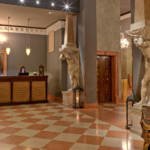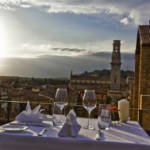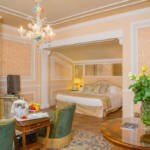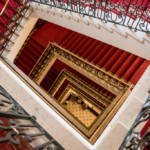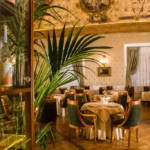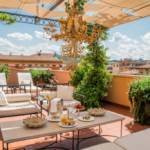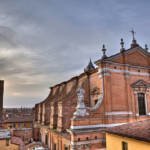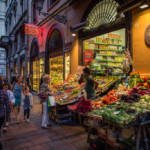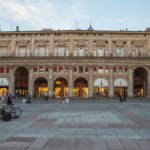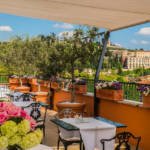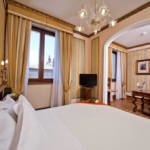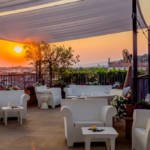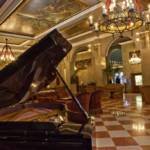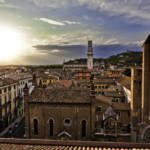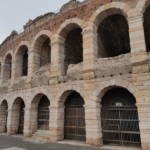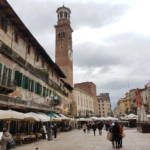Though about 150 kilometers and a province or two separate them, Bologna and Verona share many of the same traits: Roman roots, well-preserved, medieval centers where life revolves around handsome piazzas, plus great culinary traditions and designer shopping on elegant, arcaded streets. And both cities share have something else in common — five-star hotels from the Duetorrihotels, offering old world luxury and glamor, and a chance to sleep, dine and relax in settings as grand as the cities themselves.
Bologna: Living Large in La Grassa
Set about midway between Florence and Venice and the capitol of the Emilia Romagna region, Bologna earned its nickname, La Grassa (“the fat one”) due to its cuisine, which, even among Italians is considered the finest in Italy. But the moniker could just as easily apply to its thriving economy — the healthiest in Italy, the richness of its cultural offerings or the proud beauty of its piazzas, churches and public buildings. The vibe here is different than in many other Italian cities. A venerated university, founded in 1088 and the oldest in Europe, keeps the energy young and learned. Its miles and miles of elegant porticos, the vaulted passageways that shield residents from inclement weather or summer sun, are constantly buzzing with signore out for their morning shopping, foreign tourists looking to score designer goods during seasonal sales, and young Bolognese heading out for aperitivo hour and late dinners.
Just steps from all the action of Piazza Maggiore, Bologna’s largest public square and one of the grandest in Italy, is the aptly named Grand Hotel Majestic, the city’s oldest hotel and its only 5-star property. The Majestic at once oozes glamor and history, from its sparkling lobby filled with antique furnishings, polished marble surfaces and crystal chandeliers, to the 10 meters of ancient Roman road still visible on the lower level. An graceful, vaulted breakfast room dates to the 1700s, while the airy bar, Cafè Marinetti, is lined with ionic marble columns and black and white photos of famous guests — everyone from Pavarotti to Springsteen. I Carracci, the hotel’s highly rated restaurant, features 15th century ceiling frescoes from the famous Carracci brothers, including Annibale, an important figure in Baroque painting. Throughout the property, neoclassical paintings, hand-painted ceramics and other objets d’art strike a tone of whispered elegance at every turn.
Even standard guest rooms at Grand Hotel Majestic are paeans to refinement, with silk damask draperies and wall coverings, antique and period furnishings, dressing rooms and marble bathrooms fitted with both tubs and showers. Suites hit every classic luxury note, with Murano glass chandeliers, herringbone parquet floors, half-tester or 4-poster beds, plus sitting areas and furnished balconies overlooking the rooftops of Bologna. Fresh flowers, deluxe Trussardi bath amenities and huge walk-in showers make bathrooms a lush haven. For opulence on the grandest of scales, suites at the Presidential level and above, including a 2-bedroom sanctuary named after Giuseppe Verdi and one where Princess Diana once stayed, are bedecked with every possible luxury material — crystal, marble, velvet, porcelain and inlaid wood. Each suite is intended to feel like a mini-palace, and that mission is gracefully accomplished.
Must-Do Dining
La Grassa is not the city to visit if you are on a diet. Dining options will make Italophiles weep with joy, and win over even those who think they’ve had their fill of pasta. Bologna is a food-proud city, and one in which to indulge — or even over-indulge — on traditional Bolognese specialties like tagliatelle a ragu, a meaty sauce served with wide pasta noodles, or rich lasagne alla Bolognese with Béchamel sauce. If you don’t want to leave the luxurious lap of the Grand Majestic, dine at the hotel’s I Carracci, which offers elegantly prepared Bolognese classics in a splendid setting. If you want to eat light — or enjoy some hearty snacking before sitting down to dinner—head to Via Pescherie Vecchie, a narrow lane lined with lively bars and casual eateries, perfect for pre-dinner drinks or for making an evening out of it. For an all-out foodie frenzy, head to FICO, Eataly’s 100,000 square meter agro-theme park, with classes, tastings, prototype farms and 45 different eateries.
Exploring Bologna
While Bologna draws its share of tourists, it doesn’t have the blockbuster attractions of Rome or Florence. Nor does it have their crowds, which is, of course, part of its appeal. Must-see sights include Piazza Maggiore, lined with stately brick buildings, many dating to the 1200s, and Le Due Torre, the twin towers — one with a precipitous lean — that are symbols of the city. But rather than racing from one obligatory church, museum or monument to the next, let Bologna reveal itself as you walk its porticoes, explore its produce markets, admire its architecture and soak in the earthy, yet electrified environment of this intriguing Italian metropolis.
Ancient Elegance in Verona
Shakespeare likely never set foot in Verona, but the city enchanted him from afar, enough so that he set two of his plays her — the comical Two Gentlemen of Verona and the timeless romantic tragedy, Romeo and Juliet. Verona has capitalized on its ties to The Bard, but this elegant city on the Adige River offers so much more than its dubious literary connections, with well-tended streets and piazzas, high-rent real estate and shopping, and a cultural calendar on par with or superior to much, much larger European cities. Verona is an elegantly-coiffed woman of a certain age and pedigree, donned in a vintage fur coat, her hair and lipstick flawless. It’s classy, historic and achingly pretty, and has its nose just a little bit stuck in the air, maybe justifiably so.
Verona’s Fairest Due Torri Hotel
Every bit as luxurious as its sister hotel in Bologna, the 5-star Due Torri Hotel is even richer in history. The building, which dates to the 1300s, has survived plagues and war. Goethe slept here, as did a certain 13-year-old musical prodigy named Mozart. Garibaldi rallied for a unified Italy from a hotel balcony. In the hotel basement, restored frescoes by Pino Casarini, one of Italy’s most important 20th century muralists, adorn the whimsical Arena Casarini, a ballroom and event space. Set in the oldest part of the hotel, a lobby-level lounge and restaurant feels like a grand medieval dining hall transformed with rich Biedermeier furniture and accents.
Warm, colorful rooms offer ample square footage, Empire-style furnishings, separate closest/dressing rooms and pink marble bathrooms. The deluxe Maria Callas Suite — the singer was a frequent guest at Due Torri — overlooks a pretty piazza, as does the Presidential Suite, which measures a palatial 1,076 square feet. All suites have separate sitting rooms and lavish bathrooms, some with whirlpool tubs.
For dining on property, the Due Torri Restaurant serves sophisticated organic, local fare, while the newly opened Grill Restaurant, on the hotel’s open-air roof terrace, offers meat and seafood entrees, plus cocktails and appetizers and quite possibly the most enchanting view in the city.
Must-Do Dining
Only 24 diners at a time get to experience the wonders of Casa Perbellini, a 2-Michelin starred concept restaurant from Chef Giancarlo Perbellini. A completely integrated kitchen means lucky patrons witness every stage of preparation of brilliantly plated tasting menus. It’s theatre meets haute cuisine, and well-worth the detour outside the historic center — and making reservations well in advance.
For slightly less epic drinks and dining, Verona’s two largest piazzas are abuzz with options. By day, Piazza delle Erbe hosts a colorful flower, produce and souvenir market. When the sun ducks behind the surrounding buildings, the piazza comes alive as one of Italy’s most elegant living rooms — it’s lined with bars and restaurants that while perhaps not the best in the city, offer great people-watching in a delightful setting. Perched at any of the bars and restaurants on nearby Piazza Bra, you will have a ringside seat from which to gaze upon the Arena di Verona, the incredibly well preserved 1st century AD Roman arena that is the city’s star attraction.
Exploring Verona
The ancient arena, which predates the Colosseum in Rome and is larger in circumference, is a must-visit, even if you just admire it from the outside. In a city full of beautiful, historically significant churches, the religious structures known as the Cathedral Complex stand out, for their archaeological finds, including Roman-era baths and Paleo-Christian mosaics, and elegant façade guarded by two griffins.
Consider visiting Verona during its summer Opera Festival, which runs from June to August. Performances take place at the Roman Arena, an unforgettable setting. Rock concerts are regularly staged here — recent headliners include Elton John and Lenny Kravitz. VinItaly, one of the world’s most important wine exhibitions, takes place every April.
Lastly, Verona is a great city to visit with an empty suitcase. Corso Santa Anastasia features locally owned stores selling antiques, estate jewelry and handmade shoes. Departing from Piazza delle Erbe, Via Giuseppe Mazzini is Verona’s high street, with Louis Vuitton, Hugo Boss, Bialetti kitchenware, Tiffany and Co and many, many more top-shelf brands. Winter sales (saldi) start in January and run to mid-February; summer prices start dropping in July, until inventory is exhausted in August.

